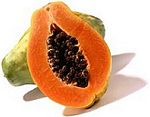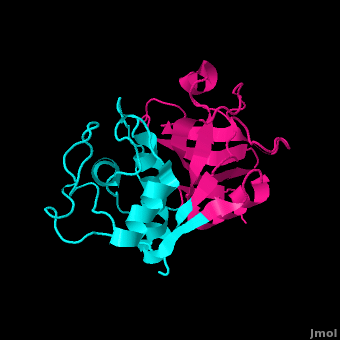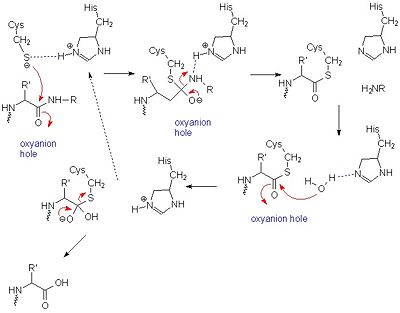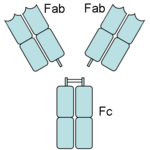Papain
From Proteopedia
| Line 1: | Line 1: | ||
| + | <StructureSection load='9pap' size='400' side='right' caption='Click on the links to the left to view different structural aspects. The PDB code for this 1.65 Å resolution structure is 9PAP.' scene='Papain/Primary_scene/1' > | ||
| + | |||
===Introduction=== | ===Introduction=== | ||
| Line 12: | Line 14: | ||
==Structure== | ==Structure== | ||
| - | <StructureSection load='9pap' size='400' side='right' caption='Click on the links to the left to view different structural aspects. The PDB code for this 1.65 Å resolution structure is 9PAP.' scene='Papain/Primary_scene/ | + | <StructureSection load='9pap' size='400' side='right' caption='Click on the links to the left to view different structural aspects. The PDB code for this 1.65 Å resolution structure is 9PAP.' scene='Papain/Primary_scene/2' > |
===General Structural Features=== | ===General Structural Features=== | ||
| - | Papain is a relatively simple enzyme, consisting of a single 212 residue chain. A majority of papain's residues, shown in purple in the link, are <scene name='Papain/Hydrophobicity_papain/1'>hydrophobic</scene>. As with all proteins, it is primarily the exclusion of these residues by water that leads to papain's assumption of a globular form. Despite its apparent simplicity and small size, papain folds into two distinct, evenly sized <scene name='Papain/Papain_domains/ | + | Papain is a relatively simple enzyme, consisting of a single 212 residue chain. A majority of papain's residues, shown in purple in the link, are <scene name='Papain/Hydrophobicity_papain/1'>hydrophobic</scene>. As with all proteins, it is primarily the exclusion of these residues by water that leads to papain's assumption of a globular form. Despite its apparent simplicity and small size, papain folds into two distinct, evenly sized <scene name='Papain/Papain_domains/2'>domains</scene>, each with its own |
<scene name='Papain/Sk_hydrophobic_core/1'>hydrophobic core</scene>. | <scene name='Papain/Sk_hydrophobic_core/1'>hydrophobic core</scene>. | ||
| - | These two subunits are held together with <scene name='Papain/Armcrossing/1'>"arm" linkage</scene>, where each protein domain holds the opposite domain. In papain's case the "arm" crossing primarily occurs on or near the surface.<ref name="Richardson" /> It is between these two domains that the <scene name='Papain/9pap_bindingpocket_wrtdomains/ | + | These two subunits are held together with <scene name='Papain/Armcrossing/1'>"arm" linkage</scene>, where each protein domain holds the opposite domain. In papain's case the "arm" crossing primarily occurs on or near the surface.<ref name="Richardson" /> It is between these two domains that the <scene name='Papain/9pap_bindingpocket_wrtdomains/3'>substrate binding pocket</scene> is situated.<ref>http://books.google.com/books?hl=en&lr=&id=fk1hbZdPTEgC&oi=fnd&pg=PA79&dq=aromatic+residues+in+papain&ots=L8SvlkQaZU&sig=xZ2l8kj52PD7DzuiAQ1zah0CU2M#v=onepage&q=aromatic%20residues%20in%20papain&f=false</ref> The two domains interact with one another via hydrophobic interactions, <scene name='Papain/Twodomainshbonds/1'>hydrogen bonds</scene>, and electrostatic interactions in this cleft. For example, <scene name='Papain/Sk_domain_contact_valine/1'>Valine-32</scene> from the L Domain hydrophobically interacts with the carbon atoms on residues Lys174, Ala162 and Pro129 of the R Domain. <scene name='Papain/Sk_domain_contact_glutamine/1'>Gln19</scene> hydrogen bonds multiple times with the oxygen atoms of Ser176 and also with the oxygen atom on Tyr88. Electrostatic interactions are seen between <scene name='Papain/Sk_domain_contact_glu_and_lys/1'>Glu35 and Lys174</scene> where the carboxyl group of Glu35 forms an ionic bond with the ammonia group of the Lys174 residue. The sum total of interactions within the cleft between the two domains ensure that the lobes do not move with respect to one another. <ref> http://books.google.com/books?hl=en&lr=&id=fk1hbZdPTEgC&oi=fnd&pg=PA79&dq=aromatic+residues+in+papain&ots=L8SvlkQaZU&sig=xZ2l8kj52PD7DzuiAQ1zah0CU2M#v=onepage&q=aromatic%20residues%20in%20papain&f=false </ref> |
In addition to hydrophobic residues, papain contains a variety of <scene name='Papain/Sk_polar_residues/1'>polar</scene> residues, some carrying a <scene name='Papain/Sk_acidic_residues/1'>negative charge</scene> (acidic) at physiological pH, others a <scene name='Papain/Sk_basic_residues/1'>positive charge</scene> (basic), the rest of the polar residues are neutral. As expected, the charged <scene name='Papain/Termini/1'>termini</scene> face outward due to their hydrophilic nature. | In addition to hydrophobic residues, papain contains a variety of <scene name='Papain/Sk_polar_residues/1'>polar</scene> residues, some carrying a <scene name='Papain/Sk_acidic_residues/1'>negative charge</scene> (acidic) at physiological pH, others a <scene name='Papain/Sk_basic_residues/1'>positive charge</scene> (basic), the rest of the polar residues are neutral. As expected, the charged <scene name='Papain/Termini/1'>termini</scene> face outward due to their hydrophilic nature. | ||
Revision as of 23:13, 3 April 2012
| |||||||||||
Contents |
Common Uses

Medicinal
Papain has been used for a plethora of medicinal purposes including treating inflammation, shingles, diarrhea, psoriasis, parasites, and many others.[22] One major use is the treatment of cutaneous ulcers including diabetic ulcers and pressure ulcers.[23] Pressures ulcers plague many bed bound individuals and are a major source of pain and discomfort. Two papain based topical drugs are Accuzyme and Panafil, which can be used to treat wounds like cutaneous ulcers.[24]
A recent New York Times article featured papain and other digestive enzymes.[25] With the number of individuals suffering from irritable bowel syndrome and other gastrointestinal issues, many people are turning toward natural digestive aid supplements like papain. The author even talks about the use of papain along with a pineapple enzyme, bromelain, in cosmetic facial masks. Dr. Adam R. Kolker (a plastic surgeon) is quoted in the article saying that "For skin that is sensitive, enzymes are wonderful." He bases these claims off the idea that proteases like papain help to break peptide bonds holding dead skin cells to the live skin cells.[26]
Commercial and Biomedical
Papain digests most proteins, often more extensively than pancreatic proteases. It has a very broad specificity and is known to cleave peptide bonds of basic amino acids and leucine and glycine residues, but prefers amino acids with large hydrophobic side chains. This non-specific nature of papain's hydrolase activity has led to its use in many and varied commercial products. It is often used as a meat tenderizer because it can hydrolyze the peptide bonds of collagen, elastin, and actomyosin. It is also used in contact lens solution to remove protein deposits on the lenses and marketed as a digestive supplement. [27] Finally, papain has several common uses in general biomedical research, including a gentle cell isolation agent, production of glycopeptides from purified proteoglycans, and solubilization of integral membrane proteins. It is also notable for its ability to specifically cleave IgG and IgM antibodies above and below the disulfide bonds that join the heavy chains and that is found between the light chain and heavy chain. This generates two monovalent Fab segments, that each have a single antibody binding sites, and an intact Fc fragment, as shown in the image to the right:[11]
Reference
- Kamphuis IG, Kalk KH, Swarte MB, Drenth J. Structure of papain refined at 1.65 A resolution. J Mol Biol. 1984 Oct 25;179(2):233-56. PMID:6502713
Page seeded by OCA on Tue Feb 17 04:20:31 2009
Proteopedia Page Contributors and Editors (what is this?)
Kirsten Eldredge, Jacinth Koh, Sara Kongkatong, Kyle Burch, Michal Harel, Joel L. Sussman, Elizabeth Miller, Samuel Bray, David Canner, Jaime Prilusky



